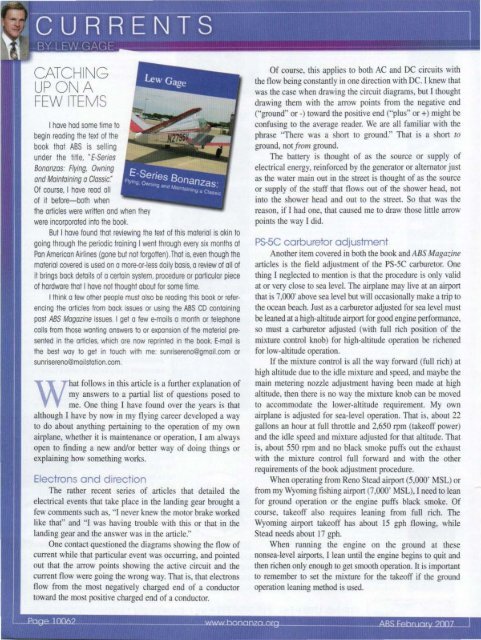February 2007 - American Bonanza Society
February 2007 - American Bonanza Society
February 2007 - American Bonanza Society
Create successful ePaper yourself
Turn your PDF publications into a flip-book with our unique Google optimized e-Paper software.
CATCHINGUPONAFEW ITEMSI hove hod some time tobegin reading the text of thebook that ABS is sellingunder the title, • E-Series<strong>Bonanza</strong>s: Flying, Owningond Maintaining a Classic:Of course, I have read allof it before-both whenthe articles were written and when theywere incorporated into the book.But I have found that reviewing the text of this material is okin togoing through the periodic training I went through every six months atPon <strong>American</strong> Airlines (gone but not forgotten). That is, even though thematerial covered is used on a more-or-Iess doily basis, a review of all ofit brings bock details of a certain system, procedure or particular pieceof hardwore that I have not thought about for some time.I think a few other people must also be reading this book or referencingthe articles from bock issues or using the ABS CD containingpost ABS Magazine issues. I get a few e-mails a month or telephonecalls from those wanting answers to or expansion of the material presentedin the articles, which are now reprinted in the book. E-mail isthe besl way 10 gel in lauch wilh me: sunrisereno@gmoil.com orsunrisereno@moilstotion.com.What follows in this article is a further explanation ofmy answers to a partial list of questions posed tome. One thing I have found over the years is thatalthough I have by now in my flying career developed a wayto do about anything pertaining to the operation of my ownairplane, whether it is maintenance or operation, I am alwaysopen to finding a new and/or better way of doing things orexplaining how something works.Electrons and directionThe rather recent series of anicles that detailed theelectrical events that take place in the landing gear brought afew comments such as, "I never knew the motor brake workedlike that" and "I was having trouble with this or that in thelanding gear and the answer was in the article."One contact questioned the diagrams showing the flow ofcurrent while that particular event was occurrin g, and pointedout that the arrow points showing the active circuit and thecurrent flow were going the wrong way. That is, that electronsflow from the most negatively charged end of a conductortoward the most positive charged end of a conductor.Of course, this applies to both AC and DC circuits withthe flow being constantly in one direction with DC. I knew thatwas the case when drawing the circuit diagrams, but I thoughtdrawing them with the arrow points from the negative end("ground" or -) toward the positive end ("plus" or +) might beconfusing to the average reader. We are all familiar with thephrase "There was a short to ground." That is a short toground, not from ground.The battery is thought of as the source or supply ofelectrical energy, reinforced by the generator or alternator justas the water main out in the street is thought of as the sourceor supply of the stuff that flows out of the shower head, notinto the shower head and out to the street. So that was thereason, if I had one, that caused me to draw those little arrowpoints the way I did.PS-5C carburetor adjustmentAnother item covered in both the book and ABS Magazinearticles is the field adjustment of the PS-5C carburetor. Onething I neglected to mention is that the procedure is only validat or very close to sea level. The airplane may live at an airportthat is 7,000' above sea level but will occasionally make a trip tothe ocean beach. Just as a carburetor adjusted for sea level mustbe leaned at a high-altitude airport for good engine performance,so must a carburetor adjusted (with full rich position of themixture control knob) for high-altitude operation be richenedfor low-altitude operation.If the mixture control is all the way forward (full rich) athigh altitude due to the idle mixture and speed, and maybe themain metering nozzle adjustment having been made at highaltitude, then there is no way the mixture knob can be movedto accommodate the lower-altitude requirement. My ownairplane is adjusted for sea-level operation. That is, about 22gallons an hour at full throttle and 2,650 rpm (takeoff power)and the idle speed and mixture adjusted for that altitude. Thatis, about 550 rpm and no black smoke puffs out the exhaustwith the mixture control full forward and with the otherrequirements of the book adjustment procedure.When operating from Reno Stead airport (5,000' MSL) orfrom my Wyoming fiShing airport (7,000' MSL), I need to leanfor ground operation or the engine puffs black smoke. Ofcourse, takeoff also requires leaning from full rich. TheWyoming airport takeoff has about 15 gph flowing , whileStead needs about 17 gph.When running the engine on the ground at thesenonsea-Ievel airports, I lean until the engine begins to quit andthen richen only enough to get smooth operation. It is importantto remember to set the mixture for the takeoff if the groundoperation leaning method is used.

















